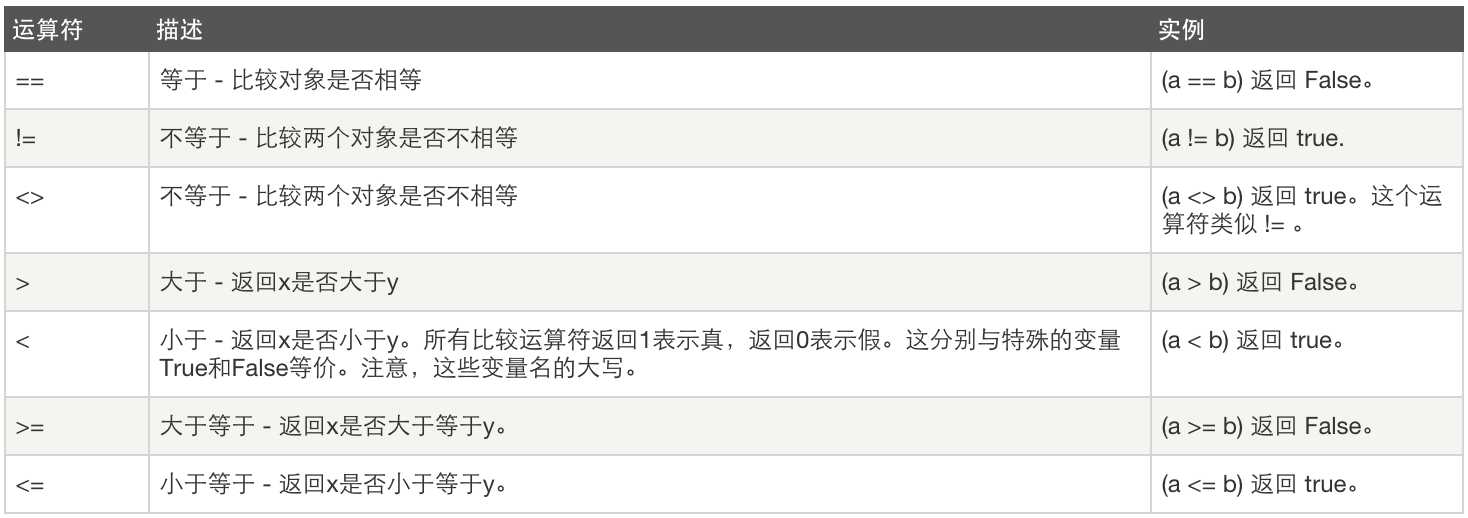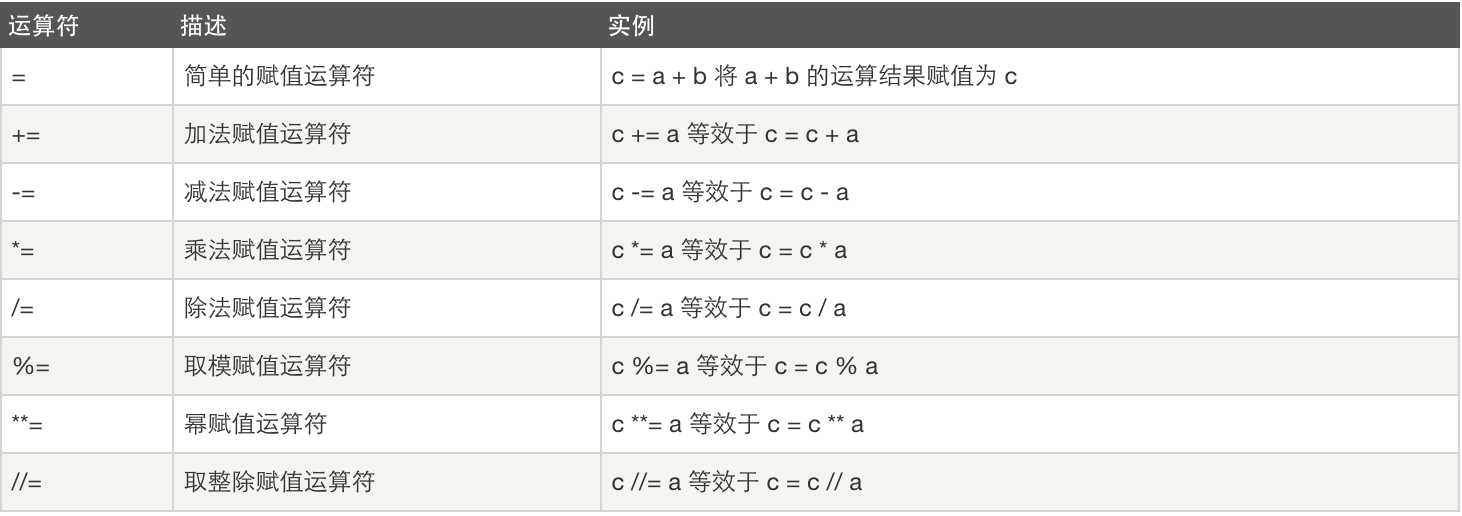标签:

2、比较运算:

3、赋值运算:

4、逻辑运算:

5、成员运算:

int(整型)

class int(object):
"""
int(x=0) -> int or long
int(x, base=10) -> int or long
Convert a number or string to an integer, or return 0 if no arguments
are given. If x is floating point, the conversion truncates towards zero.
If x is outside the integer range, the function returns a long instead.
If x is not a number or if base is given, then x must be a string or
Unicode object representing an integer literal in the given base. The
literal can be preceded by ‘+‘ or ‘-‘ and be surrounded by whitespace.
The base defaults to 10. Valid bases are 0 and 2-36. Base 0 means to
interpret the base from the string as an integer literal.
>>> int(‘0b100‘, base=0)
4
"""
def bit_length(self):
""" 返回表示该数字的时占用的最少位数 """
"""
int.bit_length() -> int
Number of bits necessary to represent self in binary.
>>> bin(37)
‘0b100101‘
>>> (37).bit_length()
6
"""
return 0
def conjugate(self, *args, **kwargs): # real signature unknown
""" 返回该复数的共轭复数 """
""" Returns self, the complex conjugate of any int. """
pass
def __abs__(self):
""" 返回绝对值 """
""" x.__abs__() <==> abs(x) """
pass
def __add__(self, y):
""" x.__add__(y) <==> x+y """
pass
def __and__(self, y):
""" x.__and__(y) <==> x&y """
pass
def __cmp__(self, y):
""" 比较两个数大小 """
""" x.__cmp__(y) <==> cmp(x,y) """
pass
def __coerce__(self, y):
""" 强制生成一个元组 """
""" x.__coerce__(y) <==> coerce(x, y) """
pass
def __divmod__(self, y):
""" 相除,得到商和余数组成的元组 """
""" x.__divmod__(y) <==> divmod(x, y) """
pass
def __div__(self, y):
""" x.__div__(y) <==> x/y """
pass
def __float__(self):
""" 转换为浮点类型 """
""" x.__float__() <==> float(x) """
pass
def __floordiv__(self, y):
""" x.__floordiv__(y) <==> x//y """
pass
def __format__(self, *args, **kwargs): # real signature unknown
pass
def __getattribute__(self, name):
""" x.__getattribute__(‘name‘) <==> x.name """
pass
def __getnewargs__(self, *args, **kwargs): # real signature unknown
""" 内部调用 __new__方法或创建对象时传入参数使用 """
pass
def __hash__(self):
"""如果对象object为哈希表类型,返回对象object的哈希值。哈希值为整数。在字典查找中,哈希值用于快速比较字典的键。两个数值如果相等,则哈希值也相等。"""
""" x.__hash__() <==> hash(x) """
pass
def __hex__(self):
""" 返回当前数的 十六进制 表示 """
""" x.__hex__() <==> hex(x) """
pass
def __index__(self):
""" 用于切片,数字无意义 """
""" x[y:z] <==> x[y.__index__():z.__index__()] """
pass
def __init__(self, x, base=10): # known special case of int.__init__
""" 构造方法,执行 x = 123 或 x = int(10) 时,自动调用,暂时忽略 """
"""
int(x=0) -> int or long
int(x, base=10) -> int or long
Convert a number or string to an integer, or return 0 if no arguments
are given. If x is floating point, the conversion truncates towards zero.
If x is outside the integer range, the function returns a long instead.
If x is not a number or if base is given, then x must be a string or
Unicode object representing an integer literal in the given base. The
literal can be preceded by ‘+‘ or ‘-‘ and be surrounded by whitespace.
The base defaults to 10. Valid bases are 0 and 2-36. Base 0 means to
interpret the base from the string as an integer literal.
>>> int(‘0b100‘, base=0)
4
# (copied from class doc)
"""
pass
def __int__(self):
""" 转换为整数 """
""" x.__int__() <==> int(x) """
pass
def __invert__(self):
""" x.__invert__() <==> ~x """
pass
def __long__(self):
""" 转换为长整数 """
""" x.__long__() <==> long(x) """
pass
def __lshift__(self, y):
""" x.__lshift__(y) <==> x<<y """
pass
def __mod__(self, y):
""" x.__mod__(y) <==> x%y """
pass
def __mul__(self, y):
""" x.__mul__(y) <==> x*y """
pass
def __neg__(self):
""" x.__neg__() <==> -x """
pass
@staticmethod # known case of __new__
def __new__(S, *more):
""" T.__new__(S, ...) -> a new object with type S, a subtype of T """
pass
def __nonzero__(self):
""" x.__nonzero__() <==> x != 0 """
pass
def __oct__(self):
""" 返回改值的 八进制 表示 """
"""